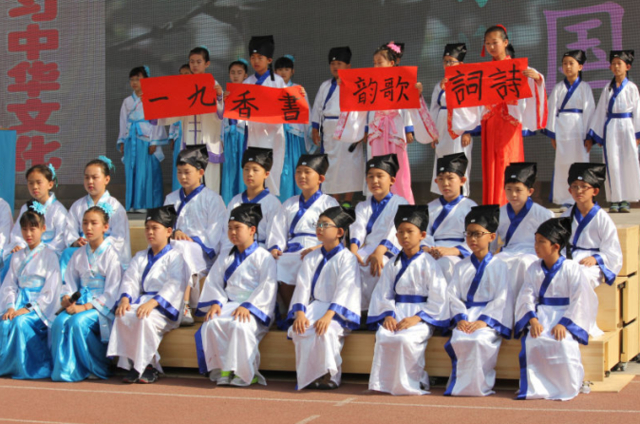Ancient poetry explains rhythmic expectations

A primary school in Haidian District, Beijing, held a competition for ancient poetry reading. Research found that Chinese people’s expectations of rhythm is closely related to how much they read ancient poetry.
Since ancient times, Chinese people have had a special taste for rhymes, and a preference for sentences with strong rhythm such as antithesis and parallelism. Recently, scholars have found that Chinese people who read ancient styles of poetry expect certain types of rhythm in their reading and writing.
Neutral response
Yang Yiming, a Changjiang Scholar and professor from the School of Linguistic Sciences and Arts at Jiangsu Normal University, said his research team investigated the interactive mechanism between cultural behavior and the brain via techniques such as eye tracking, nerve electrophysiology and nuclear magnetic resonance of brain function. Researchers analyzed the neutral cognitive mechanisms used in ancient poetry reading, and explored the possible scientific relationship between reading poetry and Chinese people’s special preference for level and oblique tones, antithesis and rhyme in writing and reading.
The research outcome found that Chinese people have established a cognitive mechanism in rhythmic formation and poetic understanding. The discovery of typical nerve electrophysiological indicator (P200) used in reading Chinese ancient poetry provides evidence for the early rhythmic effect formed in poetry reading.
Investigation of the activation time of rhythmic expectations in a general audience shows that the rhythmic rules are readily activated in an early time window, affecting the first poetry reading. Violation of the rhythmic rule will see a significant increase in the gazing time of the tested character.
“The rhythmic expectation regulates the formation of poetic rhymes in early periods, evoking a specific nerve electrophysiology indicator and eye movement pattern,” said Chen Qingrong, a professor of psychology from Nanjing Nomal University. Brain electric and eye tracking experiments provide the primary theoretical basis to reveal the rhythmic mechanism that regulates the creation of ancient styles of poetry.
Cultural genes
Chinese people love reading ancient poetry. The affection for ancient poetry has been passed down from generation to generation, forming cultural behavior patterns unique to Chinese collective unconsciousness and it has became a distinct cultural gene, Yang said.
This cultural gene makes Chinese people unconsciously discard the reading mode ususally adapted for general literary works when reading ancient poetry, thus expecting those sentences in neat forms and harmonious rhymes to comprise poetic enjoyment, Chen said.
From the perspective of comparative linguistics, Chinese language’s emphasis on rhythm is unique. Chen argued that most words of Indo-European languages are polysyllabic, with considerable words ending with a consonant. The presence of too many polysyllabic words limits the number of rhyming-words. Therefore, poetry of Indo-European origins tends to have many rhyming foots in one single poem. Also, consonants weaken the effect of the rhyme. In contrast, each Chinese character has a single pronunciation, reducing the difficulty of creating strong and unified rhymes.
Cognitive mechanism
Yang said exploration on traditional textual discourse based on poetic rhymes is only part of the research on the genes of traditional Chinese culture. Further steps should be taken to integrate the approaches of multiple disciplines to study the cognitive mechanisms that regulate rhyme and tones, in order to offer a more clear and comprehensive explanation for Chinese people’s preference for rhyme in writing and reading.
Chen argued that the skills and rules of poetry creation have a profound impact on the subsequent artistic forms. The social function embedded in poetic creation techniques delicately reflects the thoughts, wisdom and culture of a certain nation.
Poetry is an indispensable part of traditional Chinese culture and aesthetics. Rhyme is not only the form, but also the spiritual core of poetry. Wang Shimin, a professor from the Institute of Linguistics at Shanxi University, said in terms of the disciplinary classification within linguistics, phonology belongs to historical linguistics. The ultimate goal of historical linguistics is to investigate the origin and evolution of human languages. The emergence of rhyme is closely related to Chinese people’s self-identity with and pursuit for rhyme in literature and art. In order to investigate the evolution of Chinese culture and language, it is necessary to pay more attention to traditional “small studies” with research on rhyme, characters and gloss at its core.
WANG GUANGLU is a reporter at the Chinese Social Sciences Today.

 PRINT
PRINT CLOSE
CLOSE